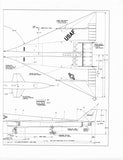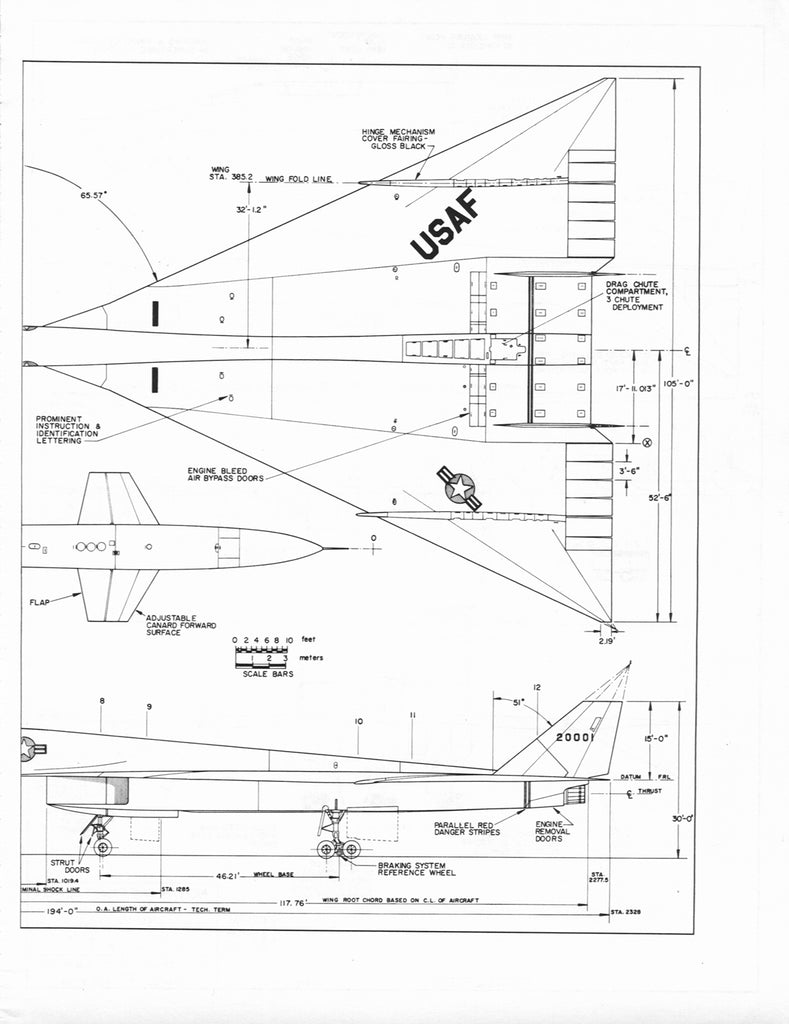Drawing - Paul Matt - North American XB-70-1 Valkyrie
$ 1.49
Brand Kiona Publishing, Inc.
The North American Aviation XB-70 Valkyrie was the prototype of the B-70 nuclear-armed, deep-penetration strategic bomber for the U.S. Air Force's Strategic Air Command. In the late 1950s North American Aviation designed the Valkyrie bomber as a large, six-engine-powered aircraft capable. It was capable of reaching Mach 3+ while flying at 70,000 feet.
At speed, it was expected the B-70 would be almost immune to interceptor aircraft, the only effective weapon against bomber aircraft at the time. However, the introduction of the first Soviet surface-to-air missiles in the late 1950s put the near-invulnerability of the B-70 in doubt. As the strategic role passed from bombers to intercontinental ballistic missiles (ICBMs) during the late 1950s, manned bombers were increasingly seen as obsolete. Consequently, the USAF eventually gave up fighting for its production, and the B-70 program was canceled in 1961. Development was subsequently turned over to a research program to study the effects of long-duration high-speed flight. As such, two prototype aircraft were built, and designated XB-70A. These aircraft were used for supersonic test-flights from 1964 thru 1969. In 1966, one prototype crashed after colliding in mid-air with a smaller jet aircraft. The remaining Valkyrie is in the National Museum of the United States Air Force near Dayton, Ohio.
The XB-70's maiden flight was on September 21, 1964. In the first flight test, between Palmdale and Edwards AFB, one engine had to be shut down shortly after takeoff, and an undercarriage malfunction warning meant the flight was flown with the undercarriage down as a precaution, limiting its speed to 390 mph — about half that planned. On landing, the rear wheels of the port side main gear locked, the tires ruptured, and a fire started.
The Valkyrie went supersonic (Mach 1.1) on the third test flight on October 12, 1964. It flew above Mach 1 for 40 minutes during a flight on October 24. The wing tips were also lowered partially in this flight. XB-70 No. 1 surpassed Mach 3 on October 14, 1965 by reaching Mach 3.02 at 70,000 ft (21,300 m). The first aircraft was found to suffer from weaknesses in the honeycomb panels. On two occasions, honeycomb panels failed and were torn off during supersonic flight, which resulted in a Mach 2.5 limit on the aircraft.
The deficiencies discovered on AV-1 were almost completely solved on the second XB-70, which first flew on July 17, 1965. On January 3, 1966, XB-70 No. 2 attained Mach 3.05 while flying at 72,000 ft (21,900 m). AV-2 reached Mach 3.08 and maintained it for 20 minutes on April 12, 1966. On May 19, 1966, AV-2 reached Mach 3.06 and flew at Mach 3 for 32 minutes, covering 2,400 mi (3,840 km) in 91 minutes.
In 1966, AV-2 was selected for the National Sonic Boom Program (NSBP) program and was outfitted with test sensors. It flew the first sonic boom test on June 6, 1966, attaining a speed of Mach 3.05 at 72,000 ft (21,900 m). Two days later, AV-2 crashed following a mid-air collision with an F-104 while flying in a multi-aircraft formation. Sonic boom and later testing continued with XB-70A #1.
The second flight research program (NASA NAS4-1174) investigated "control of structural dynamics" from April 25, 1967 through the XB-70's last flight in 1969. It was found that at high altitude and high speed, the XB-70A experienced unwanted changes in altitude. NASA testing from June 1968 included two small vanes on the nose of AV-1 for measuring the response of the aircraft's stability augmentation system. AV-1 flew a total of 83 flights.
The XB-70's last supersonic flight took place on December 17, 1968. On February 4, 1969, AV-1 took its final flight to Wright-Patterson Air Force Base for museum display. Flight data was collected on this subsonic trip. North American Rockwell completed a four-volume report on the B-70 that was published by NASA in April 1972.
Crash
On 8 June 1966, XB-70A No. 2 was in close formation with four other aircraft: F-4, F-5, T-38, and F-104. After the completion of a photoshoot, for General Electric (the engine maker) the F-104 drifted into contact with the XB-70's right wing. It flipped over and rolled inverted over the top of the Valkyrie, striking the vertical stabilizers and left wing of the bomber. The F-104 exploded, destroying the Valkyrie's rudders and damaging its left wing. With the loss of both rudders and damage to the wings, the Valkyrie entered an uncontrollable spin and crashed into the ground north of Barstow, California. NASA Chief Test Pilot Joe Walker (F-104 pilot) and Carl Cross (XB-70 co-pilot) were killed. Al White (XB-70 pilot) ejected, but sustained serious injuries, including one arm crushed by the closing clamshell-like escape crew capsule moments prior to ejection.
Specifications
- Crew: 2
- Length: 189 ft 0 in. (57.6 m)
- Wingspan: 105 ft 0 in. (32 m)
- Height: 30 ft 0 in. (9.1 m)
- Wing area: 6,297 ft2 (585 m2)
- Airfoil: Hexagonal; 0.30 Hex modified root, 0.70 Hex modified tip
- Empty weight: 253,600 lb (115,030 kg; operating empty weight)
- Loaded weight: 534,700 lb (242,500 kg)
- Max. takeoff weight: 542,000 lb (246,000 kg)
- Wing loading: 84.93 lb/ft2 (414.7 kg/m2)
- Powerplant: 6 - General Electric YJ93-GE-3 after-burning turbojet
- Dry thrust: 19,900 lbf (84 kN) each
- Thrust with afterburner: 28,800 lbf (128 kN) each
- Internal fuel capacity: 300,000 lb (136,100 kg) or 46,745 U.S. gallons (177,000 L)
- Maximum speed: Mach 3.1 (2,056 mph, 3,309 km/h)
- Cruise speed: Mach 3.0 (2,000 mph, 3,200 km/h)
- Range: 3,725 nmi (4,288 mi, 6,900 km) on combat mission
- Service ceiling: 77,350 ft (23,600 m)
- Lift-to-drag ratio: about 6 at Mach 2
- Thrust-to-weight: 0.314
- Longest flight: 3:40 hours (January 6, 1966)
- Fastest speed: 2,020 mph (3,250 km/h) (January 12,1966)
- Highest altitude: 74,000 ft (23,000 m) (March 19, 1966)
- Highest Mach number: Mach 3.08 (April 12, 1966)
- Sustained Mach 3: 32 minutes (May 19, 1966)
- Mach 3 total: 108 minutes / 10 flights
* All drawings and photos are high resolution — 300 dpi


